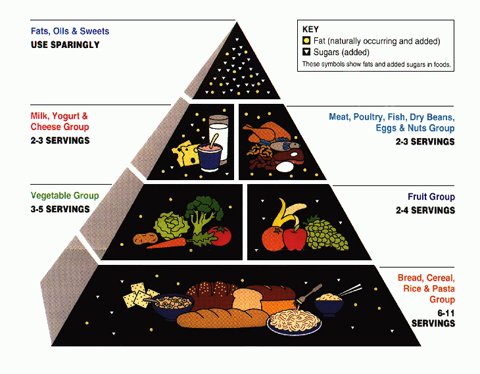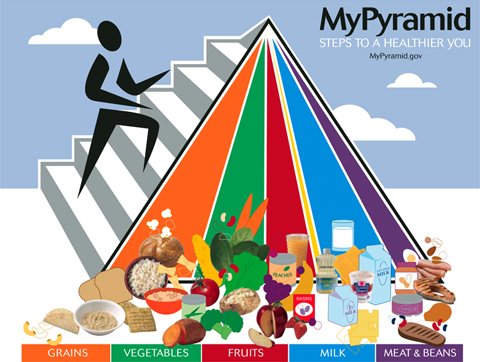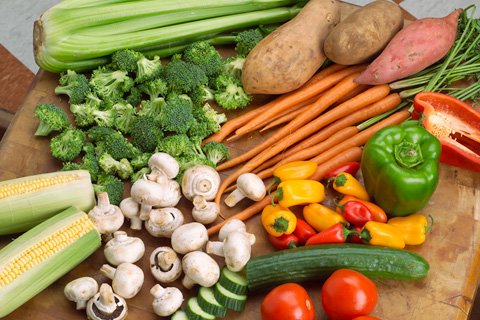Man, I need to start off with a little disclaimer on this article. The subject at hand is one that truly gets my blood boiling and frustrates me that we have something like this out there which is a "guideline to good health". I call it a bunch of cr@p. For those of you who read my articles, you know I hold nothing back and tell it like it is.
Well this is one of those articles. So if you aren't into hearing the truth about something started back in 1992 which is making the US fatter every year, then click the little "x" at the top of your screen now because you aren't going to like what you are about to read. If so, I wish you the best with your health and hope you see the light soon.
For those who are into their health and living a healthy lifestyle, read on and enjoy. I'm sure you too, soon after beginning to read this, will sit there and question how something like this could be published by the USDA as a guideline for all Americans to follow.
Do they want us to get fat and increase our chances of illness/disease? I'd love nothing more than to educate people and teach them how to live a long and healthy life. But I guess that's just me.
The History Of The Food Pyramid
Back in 1992 in an undisclosed location (adding a little mystery to this "great" idea they had, yes sarcasm) a group of people huddled around to form something in which they thought would be the answer to helping people stay healthy. Placing into action a "Food Pyramid" which would be a model for all Americans to follow to ensure healthy eating is what they decided on.
On paper it all looked good, but in theory it was lacking quite a bit. Actually so much, that what they have in place is a great way to gain excess weight/body fat and compromise Americans health as a whole.
When it comes down to it, the Food Pyramid had hardly any scientific background behind it. In fact, it has been mentioned and speculated that it reflects what was going on politically. The positioning of many of the foods in the Pyramid were supposedly changed after the specific industries lobbied to have them moved to a better location on the pyramid. Guess who won? Take a look at the bottom of the pyramid.
When the Food Pyramid was created about 56% of Americans were overweight. By 2004 65% of American adults were considered overweight. So in the span of 12 years the number rose 9%. Now you might look at that percentage and think it isn't too bad, but take into consideration the amount of people in the United States (and the number continues to grow). That's millions of people!
Now you see where I'm going with this. A study done at the John Hopkins Bloomberg School of Public Health showed that over the past few decades the number of overweight American adults has significantly increased and they propose that if the rate continues at the rate at which it is going, by the year 2030 over 86% of American adults will be overweight.
Staggering and extremely scary numbers! With that being the case, what do you think will happen with disease and illness? Yeah, that's going to significantly increase as well! The outcome is gloomy, people. We need to take a good, hard look at the direction we are headed. Do you want to be part of that statistic? I sure don't.
What Makes Up The Food Pyramid?
So what exactly makes up the Food Pyramid? It consists of 6 categories. Each category is given a number of servings to strive for daily. Below you will find what they suggest as well as what constitutes a serving:
Bread/Cereal/Rice/Pasta: 6-11 Servings
- 1 slice of bread
- 1 ounce of ready-to-eat cereal
- 1/2 cup of cooked cereal, rice, or pasta
strong>Vegetables: 3-5 Servings
- 1 cup of raw leafy vegetables
- 1/2 cup of other vegetables, cooked or chopped raw
- 3/4 cup of vegetable juice
Fruits: 2-4 Servings
- 1 medium apple, banana, orange
- 1/2 cup of chopped, cooked, or canned fruit
- 3/4 cup of fruit juice
Milk/Yogurt/Cheese: 2-3 Servings
- 1 cup of milk or yogurt
- 1 1/2 ounces of natural cheese
- 2 ounces of process cheese
Meat/Poultry/Fish/Dry Beans/Eggs/Nuts: 2-3 Servings
- 2-3 ounces of cooked lean meat, poultry, or fish
- 1/2 cup of cooked dry beans, 1 egg, or 2 tablespoons of peanut butter count as 1 ounce of lean meat
Fats/Oils/Sweets:
- Use sparingly
I'm not simply doing this for all the bodybuilders and fitness enthusiasts out there even though this will be directly posted on the Bodybuilding.com website. I want the whole American population to be able to take a look at this and change their diet even if they aren't currently engaging in an exercise program.
Let's take someone who doesn't necessarily eat bad by any means and works out on a regular basis. Now let's say he weighs 168 pounds and is pretty lean at around 9% body fat. That gives him a lean mass of around 152 pounds. Just to maintain his lean mass he should be taking in at least 1 g of protein per pound of bodyweight which equates out to 152 g of protein each day.
Looking at the Food Pyramid, he would need to take in 152 g of protein in 2-3 servings. That would mean each meal would have to have around 50 g of protein. We all know that you need to take in 5-7 small meals throughout the day to keep the metabolism revved up. There in lies another downfall to the pyramid. It doesn't set out frequency of meals.
But going back to our 168 pound friend. According to the pyramid, he can take in 6-11 servings of bread a day. He decides to go for all 11 servings by eating 11 pieces of white bread throughout the day. Just so happens commercially produced white bread that you can buy at the grocery store per slice has around 66 calories and 13 g of carbohydrates.
Now without him eating anything else but 11 pieces of bread, for the day he already is looking at 726 calories and 143 g of carbs. If your eyes aren't popping out they should be. That is just one section of the Food Pyramid for the day. His blood sugar from the white bread would be through the roof!
Examining Each Category
Let's take a look at each category and further break it down to show why it isn't very well thought out.
Bread/Cereal/Rice/Pasta
A key to this category that is missing is the difference between "good" and "bad" carbs. Similar to fats, there are carbohydrates that you want in your diet and then those that you don't. The pyramid doesn't separate the two let alone even mention the difference. You have simple and complex carbs.
Obviously some will be high-glycemic and jack up insulin in the body and low-glycemic which keeps insulin levels normal and steady. When looking at bread, for example, you have many different choices.
You look up and down the rows and see rye, Italian, white, wheat, pumpernickel, sourdough, etc. What you really need to do is look at the back of them.
Pick something that is a whole wheat bread if you want a healthy choice. Same goes for pasta; if you want it, pick the whole wheat version. Similarly when looking at rice, rather than grabbing the white rice go with a healthier brown rice.
And cereal... man we could write a few pages on cereal. I'll keep it simple, the less ingredients the better (that goes with pretty much anything). Stay clear of the sugary cereals and oatmeal and stick with the whole grain versions.
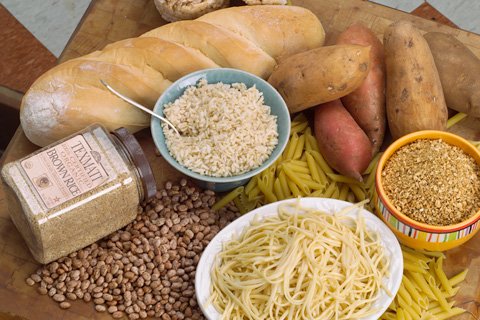
 Click Image To Enlarge.
Click Image To Enlarge. There Are Carbohydrates That You Want In
Your Diet And Then Those That You Don't.
Vegetables
Go green! No we aren't talking about recycling and reusing resources, we are talking about green vegetables. Lettuce, spinach, broccoli, peas, green beans, asparagus, etc.
Load up on these sources as they have the best nutritional profile and also supply the body with a great amount of antioxidants to fight off free radicals that try and damage our cells. You can also substitute yams or sweet potatoes for regular old potatoes.
Fruits
Pretty hard to go wrong here. Fruits like apples, peaches, bananas, and pears are great choices when shopping in this category.
Make sure that you are buying the natural version and not the canned version of them as they are loaded with tons of unnecessary sugars that you want to stay away from.
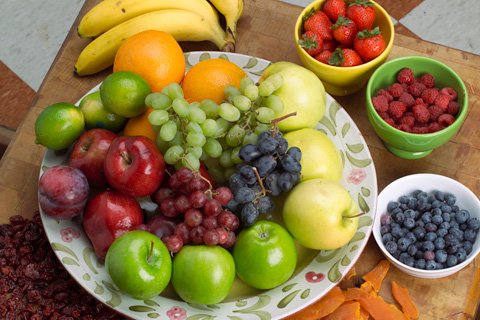
 Click Image To Enlarge.
Click Image To Enlarge. Fruits Like Apples, Peaches, Bananas, And Pears
Are Great Choices When Shopping In This Category.
Milk/Yogurt/Cheese
This should not come as a surprise, but stick to the low percentage fat dairy. That means continue past the whole milk until you get to the skim or 2% version. Whole milk is slammed with fat that you don't need in your diet.
If you enjoy the taste, soy is a great alternative. Yogurts—be cautious of, as they can be loaded with a lot of sugars that you are trying to stay away from.
Many have fruit (which isn't bad as long as it is real fruit), candy pieces, and fillers that are unnecessary in helping you stay lean and healthy.
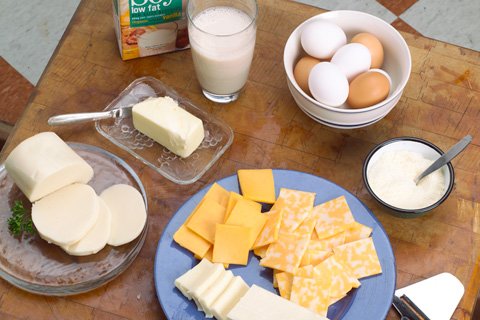
 Click Image To Enlarge.
Click Image To Enlarge. This Should Not Come As A Surprise,
But Stick To The Low Percentage Fat Dairy.
Meat/Poultry/Fish/Dry Beans/Eggs/Nuts
Things you definitely want to add from this category are lean meats, skinless chicken or turkey breast (not the deli style), any type of fish, dry beans are a great addition to a meal, eggs (preferably egg whites), and nuts such as almonds/sunflower seeds/cashews/peanuts (all of which you should look for no salt versions of to limit your sodium intake).
Fats/Oils/Sweets
This category is a section that I really think the USDA missed the boat. What they are implying is that all fats are bad. This is clearly not the case.
You have good fats which are necessary in everyday functioning of the body. Then there are bad fats such as the saturated fats that you are accustomed to seeing at a fast food restaurant.
Fish for example has a good amount of omega-3 fatty acids which are the good fats that you need. Nuts (such as almonds) are also a good source of healthy fat.
Reading the back label of products is very important. Make sure there are no hydrogenated fats or oils in the product, these are considered trans fats and should be avoided at all costs.
Olive oil is a great choice if cooking or adding to a dish (such as your whole wheat pasta). Candy and sugar should be avoided at all cost.
There is nothing healthy about it (except when looking at dark chocolate which has antioxidants in it which are good). Continue past these types of products and resist the urge.
Soda and sugary drinks should be avoided at all costs as well, including the diet versions—there is nothing healthy about any of them.
In terms of alcohol, it appears red wine is your best option and a glass a day has been shown to be healthy for the heart. Other alcoholic beverage should be consumed sparingly.
Problems With The Pyramid
So there should be no shock as to why the rate of overweight Americans is on the rise after looking at the pyramid which does not differentiate between healthy options in each category. Instead it groups them all under one umbrella and makes us the consumers figure out which is better.
But if you don't know the difference to begin with, then how do you know any better? You don't. There in lies my point. The guidelines put in place for the Food Pyramid are lacking a good set of guidelines that all Americans should be following. Without having these in place, people get confused as to what food choices are healthy or unhealthy.
The Pyramid focuses too much on carbohydrates and assumes that all those carbohydrates are equal as well as all fats being equal. The recommended servings of vegetables are good, but they are again assuming all vegetables are equal.
Eating three white potatoes a day to meet your requirements is a horrible option. But how would you know you're doing it all wrong? As far as you're concerned you are just doing what the Pyramid shows. The protein servings on the Pyramid is way too low.
You need a source of protein in every meal you eat. So if you are taking in 5-7 meals a day, you want to get 5-7 servings of protein a day. Now I'm not saying eat seven 10 ounces steaks. Serving sizes around the 4-6 ounce range depending on your weight will be fine.
About the only thing on the Pyramid that I do agree with is the sweets portion of it. They definitely need to be eaten sparingly and if you can, avoided at all costs.
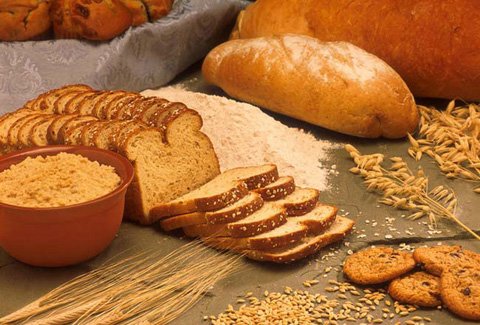
 Click Image To Enlarge.
Click Image To Enlarge. The Pyramid Focuses Too Much On Carbohydrates
And Assumes That All Those Carbohydrates Are Equal.
The Media's Effect
I am not alone with my thinking on this. There is research published in the American Journal of Clinical Nutrition that showed the Food Pyramid to do very little in terms of lowering your risk of illness and disease.
They state just as I have, that everything seems to be a little backwards in that even though they recommend we eat more vegetables in our diet, the fact that a majority of our diet (according to the pyramid) is to be consumed with an over abundance of carbohydrates and less fat is counter productive.
The sad part is all the marketing that is put into these products. When you go to the grocery store, pick up a box of one of your favorite childhood sugary cereals and see what you find. Ah, there it is! The Food Pyramid! Giving you assurance that this must be healthy for you because it is pointing out that it is part of your daily servings on the Food Pyramid.
Think of all the kids that are eating these sugary cereals which are giving them no nutritional benefit at all. Heck, let's take this even one step further.
Schools base their lunches off of the Pyramid, assuming that if they follow those guidelines that they are giving kids a healthy lunch. It's no wonder kids love the school food, they get pizza, grilled cheese, chicken nuggets, canned fruit, a bowl of vegetables, etc.
According to the Pyramid they fit within the allowed servings. But healthy choices are the key words here. Are those really healthy choices? No, not even close.
So even in schools where they are suppose to be teaching our kids how to make smart choices in terms of healthy foods they themselves are leading by a poor example.

 Click Image To Enlarge.
Click Image To Enlarge. Schools Base Their Lunches Off Of The Pyramid, Assuming That If They
Follow Those Guidelines That They Are Giving Kids A Healthy Lunch.
What About Supplements and Exercise?
We didn't even touch on a major portion of all this and I don't want to get too far off track here. They completely forgot to throw exercise in there!
They could have at least mentioned daily exercise along with proper nutrition is the key to staying fit and healthy. You simply cannot have one or the other if your goal is to stay fit and healthy. That's like trying to write a note on a piece of paper but you have no ink in the pen.
There needs to also be guidelines in place that can recommend different amounts of servings based on your activity level. Someone who is sedentary all day clearly doesn't need as much food/macronutrients as someone who is active all day long and exercises.
Something needs to be put in place to recommend a lower scaled serving suggestion for those non active and a higher scaled serving suggestion for those who are active. Not only the exercise aspect of it, but what about a multivitamin/mineral?
We simply cannot get all the vitamins and minerals we need from diet alone. Not only that but supplements in general aren't a bad thing. For those working out the benefits of supplementing with protein powders, creatine, glutamine, would do nothing but good for them. This is another topic that needs to be addressed on the Food Pyramid (when they update it).
Conclusion
When it comes down to it, we all want to live a long healthy life. We are brought up our whole life surrounded by guidelines that help us get to where we want to go. If these guidelines are incorrect, they lead us in a direction we don't want to go. All I'm saying is there needs to be something done.
We cannot sit around and allow people to be pointed in the direction we are headed. If the statistics in this article don't shock you and open your eyes, I'm saddened to say that you too might one day be the statistic. I for one want to be on the smaller statistic that shows the healthy individuals in the United States who eats healthy and exercises regularly.
I want to help people reach their health and fitness goals and strive for excellence in all they do. We all want to be healthy. Free of sickness and disease. There is nothing worse than watching a loved one slowly slip away due to an illness that might have been prevented years prior if they changed some of their habits.
I wish nothing but long life and prosperity to all of you. I hope you follow the ways to a healthier lifestyle and truly feel the benefits that come along with it. After all, the only true wealth is health.
References
- McCullough, M.L., Feskanich, D., Stampfer, M.J., et al., "Diet Quality and Major Chronic Disease Risk in Men and Women: Moving toward Improved Dietary Guidance," American Journal of Clinical Nutrition, 76, 2002, pages 1261-1271. Willett, W.C., and Stampfer, M.J., "Rebuilding the Food Pyramid," Scientific American, January 2003, pages 64-71.
- Youfa Wang, May A. Beydoun, Lan Liang, Benjamin Caballero and Shiriki K. Kumanyika. Will All Americans Become Overweight or Obese? Estimating the Progression and Cost of the US Obesity Epidemic. Obesity, Advance online publication, July 24, 2008 DOI: doi:10.1038/oby.2008.351

